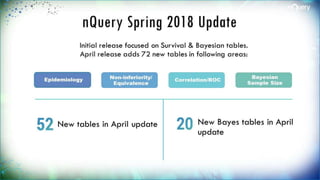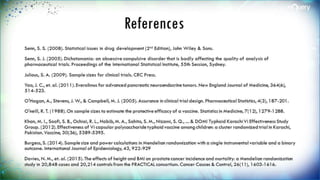Practical Methods To Overcome Sample Size Challenges
- 1. Webinar Begins at 15:00 BST/10:00 EST
- 2. Head of Statistics nQuery Lead Researcher FDA Guest Speaker Guest Lecturer Demo Host HOSTED BY: Ronan Fitzpatrick
- 3. Webinar Overview Introducing Sample Size Determination Overcoming Sample Size Calculation Challenges Overcoming Study Design Challenges Discussion and Conclusions
- 4. Worked Examples Overview Two Sample Survival Case-Control Vaccine Efficacy Cluster Randomized Trials Mendelian Randomization WORKED EXAMPLES
- 5. In 2017, 90% of organizations with clinical trials approved by the FDA used nQuery for sample size and power calculation
- 7. Sample Size Determination (SSD) Review SSD finds the appropriate sample size for your study Common metrics are statistical power, interval width or cost SSD seeks to balance ethical and practical issues A standard design requirement for regulatory purposes SSD is crucial to arrive at valid conclusions in a study
- 8. 𝑧 = 𝑥1 − 𝑥2 𝑛 𝑠 2 1 𝛿 = 𝜇1 − 𝜇2 𝜎 2 𝑃𝑜𝑤𝑒𝑟 = 1 − 𝛽 = 𝑃 𝑧 > 𝑧1−𝛼 𝐻1 3 = 𝑃 𝑧 − 𝛿 𝑛 2 > 𝑧1−𝛼 − 𝛿 𝑛 2 |𝐻1 4 𝑧 − 𝛿 𝑛 2 ~ 𝑁 0,1 5 1 − 𝛽 = 1 − 𝛷 𝑧1−𝛼 − 𝛿 𝑛 2 6 𝑧1−𝛽 = 𝛿 𝑛 2 − 𝑧1−𝛼 7 𝑛 = 2 𝑧1−𝛽 + 𝑧1−𝛼 2 𝛿2 8
- 9. 5 Essential Steps for Sample Size 1 Plan Study Study question, primary outcome, method 2 Specify Parameters Significance Level, Standard deviation, dispersion 3 Choose Effect Size Expected/targeted difference, ratio or effect size 4 Compute Sample Sample Size for specified metric such as
- 11. “Basic” SSD Challenges •80/90% Power standard •90% gives “optimism” adjustment •90% = implicit 2-study adjustment •Some Sample size adjustments •Dropout, Unequal, CRT choices •Easier: N(D) = N/(1- P(Dropout)) •Harder: Survival, Simulation, MNAR •For fixed sample size,
- 12. Dealing with Planning Uncertainty •SSD occurs before trial so uncertainty is intrinsic challenge •Will specify multiple parameters •Some Fixed (α), some unknown (σ) •More Parameters, More Assumptions •Justify, if possible, your estimates •Pilot study, previous data, other studies, elicitation, guesswork etc.
- 13. Exploring SSD Planning Uncertainty •Biggest Pitfall: Not bothering •Should explore all assumptions •Design, ES, other values, N, power •Should do Sensitivity Analysis •What scenarios to test? (95% CI) •How confident in first N estimate? •Focus where uncertain/large effect “The method by which the sample size is calculated should be given in the protocol, together with the estimates of any quantities used in the calculations (such as variances, mean values, response rates, event rates, difference to be detected)… It is important to investigate the sensitivity of the sample size estimate to a variety of deviations from these assumptions…” -ICH E9: Statistical Principles
- 14. How to Select the Correct Effect Size? •Differing opinions on meaning •Expected, clinical sig., standardised •“Minimum value worth detecting” •# of approaches to find value •Mix and match sources/methods •Approach and meaning linked •Do not reverse justify from N! Source: S. Julious (2017)
- 15. Sample Size for Survival AnalysisSurvival Analysis is about the expected duration of time to an event Methods like log-rank test & Cox Model Power is related to the number of events NOT the sample size Sample Size = Subjects to get no. of events Flexibility expected in survival analysis methods and estimation Sample Size methods need to follow suit but can make mistakes easier! Source: SEER, NCI
- 16. Considerations in Survival Sample Size What is the expected survival curve(s) in the group(s)? Assume parametric approximation? Which test appropriate? Effect of unequal follow-up due to accrual period? What accrual pattern to assume? Set max follow-up same for all? How to deal with expected dropouts or censoring? Simple loss-to-follow-up or integrate dropout
- 17. Survival Analysis Example “Using an unstratified log-rank test at the one-sided 2.5% significance level, a total of 282 events would allow 92.6% power to demonstrate a 33% risk reduction (hazard ratio for RAD/placebo of about 0.67, as calculated from an anticipated 50% increase in median PFS, from 6 months in placebo arm to 9 months in the RAD001 arm). With a uniform accrual of approximately 23 patients per month over 74 weeks and a minimum follow up of 39 weeks, a total of 352 patients would be required to obtain 282 PFS events, assuming an exponential progression-free survival distribution with a median of 6 months in the Placebo arm and of 9 months in RAD001 arm. With an estimated 10% lost to follow up patients, a total sample size of 392 Source: nejm.org Parameter Value Significance Level (One-Sided) 0.025 Placebo Median Survival (months) 6 Everolimus Median Survival (months) 9 Hazard Ratio 0.6666 7 Accrual Period (Weeks) 74 Minimum Follow-Up (Weeks) 39
- 18. Assurance for Clinical Trials Assurance (a.k.a “Bayesian Power”) is the unconditional probability of significance given a prior Focus on methods proposed by O’Hagan et al. (2005) Assurance is the expectation of the power averaged over a prior distribution for the effect Often framed the “true probability of success” of a trial Can be considered as a Bayesian analogue to Source: O’Hagan (2005)
- 20. Study Design and Sample Size •Fail to prepare, prepare to fail – Design, Design, Design! •SSD is one part of design process •Hypotheses, methods etc (next slide) •To start can rely on “standard” method •Consider choices effect on power •See “dichotomania”, different methods strengths/weaknesses •Power can also highlight poor Source: S. Senn (2005)
- 21. Common Design Considerations & SSD 1. Basic Design Considerations and Options Data type, # groups, matching, covariates, rare event?, RCT? 2. Study Objective Considerations and Options Hypothesis Type(s), primary endpoint(s), co- primary/secondary? 3. Complex Design Considerations and Options Observational/retrospective, randomization, adaptive methods 4. Statistical Considerations and Options Statistical model, assumptions, adjustments,
- 22. Vaccine Study Sample Size Background Vaccine trials typically rely on randomized trials but deal with specific issues Rare events, large sample size, event lag, clustering in population studies Due to above wider variety of methods and evidence sources used pre & post approval Will explore briefly here Source: R. Ahlawat (2015)
- 23. Vaccine Efficacy Subject-Level Example “An investigator desires a 95 per cent confidence interval for VE where he anticipates that the prevalence rate of vaccine exposure in the control group is 20 per cent, and the vaccine efficacy VE is 80 per cent and the desired relative width of the interval is 0.30. That is, the absolute width of the confidence interval will be (0.8x0.3) = 0.24 … for C = 1 where the numbers of cases and controls are equal yields a case sample size of 336. For C = 4, a 4 to 1 control to case size ratio, the case sample Source: Wiley.com Parameter Value Confidence Level (Two- Sided) 0.95 Vaccine Efficacy 0.8 Control Disease Prevalence 0.2 Relative Width (Absolute) 0.3 (0.24) Case to Controls Ratio 1,4
- 24. Vaccine Efficacy Area-Level CRT Example “A total of approximately 24,834 participants will be needed in order to have 80% power to detect a 60% vaccine protection at a 5% level of significance (two-tailed). This sample size calculation assumed a minimum cumulative typhoid incidence of 2.8 per 1,000 (during 2 years) and between cluster coefficient of variation (CV) of 0.5. Assuming an annual attrition rate of 10% a total sample of 27,592 participants is needed. Each cluster will be composed of groups of households. Cluster size will be 200-600 individuals (120 Source: ScienceDirect.com Parameter Value Significance Level (2- sided) 0.05 Expected Control Incidence Rate 0.0028 Treatment Incidence Rate 0.00112 Coefficient of Variation 0.5 Sample Size per Cluster 207 Power 80%
- 25. Mendelian Randomization Studies Mendelian Randomization (MR) uses underlying genetic variation to make causal inferences Uses genes with well understood link between polymorphism(s) and relevant intermediate phenotype Note that gene must be indirectly related to exposure of interest MR uses gene(s) as an Source: S. Burgess et. al. (2012)
- 26. Mendelian Randomization Example “We computed F statistics and R 2 values (the proportion of variation in height and BMI explained by the genetic risk score) from the linear regression to evaluate the strength of the genetic risk score instruments in a population of men at increased risk of cancer. We had 82 and 78 % power to detect an odds ratio of 1.12 and 1.25 for the effects of height and BMI on prostate cancer risk, assuming a sample size of 41,062 and that the genetic risk scores explained 6.31 and 1.46 % of the variation Source: Springer.com Parameter Value Significance Level (Two- Sided) 0.05 Positive Outcome Proportion 0.5 Odds Ratio 1.12/1.25 Variance Explained 0.0631/0.01 46
- 28. Discussion and Conclusions SSD one of many integral parts of planning process SSD emerges from study plan & statistical method/model More planning = easier sample size determination Design carefully given study type and constraints In SSD think hard on both explicit & implicit assumptions
- 29. nQuery Timeline nTerim introduced G.S.T C.R.T Count Data MANOVA / ANOVA Launch of nQuery Advanced New platform = Modern all-in-one software solution New Bayesian Module Survival Focus IQ/OQ Tools 52 new Core Tables 20 new Bayes Tables -Launch of nQuery Advisor 1.0 Developed by Dr. Janet D. Elashoff -Contiguous Innovation and releases 2007 - 2016 2017 Spring 20181996-2007
- 30. nQuery Spring 2018 Update Initial release focused on Survival & Bayesian tables. April release adds 72 new tables in following areas: New Bayes tables in April update New tables in April update Epidemiology Non-inferiority/ Equivalence Correlation/ROC Bayesian Sample Size
- 31. Q&A Any Questions? For further details, contact at: info@statsols.com Thanks for listening!
- 32. References Senn, S. S. (2008). Statistical issues in drug development (2nd Edition), John Wiley & Sons. Senn, S. J. (2005). Dichotomania: an obsessive compulsive disorder that is badly affecting the quality of analysis of pharmaceutical trials. Proceedings of the International Statistical Institute, 55th Session, Sydney. Julious, S. A. (2009). Sample sizes for clinical trials. CRC Press. Yao, J. C., et. al. (2011). Everolimus for advanced pancreatic neuroendocrine tumors. New England Journal of Medicine, 364(6), 514-523. O'Hagan, A., Stevens, J. W., & Campbell, M. J. (2005). Assurance in clinical trial design. Pharmaceutical Statistics, 4(3), 187-201. O'neill, R. T. (1988). On sample sizes to estimate the protective efficacy of a vaccine. Statistics in Medicine, 7(12), 1279-1288. Khan, M. I., Soofi, S. B., Ochiai, R. L., Habib, M. A., Sahito, S. M., Nizami, S. Q., ... & DOMI Typhoid Karachi Vi Effectiveness Study Group. (2012). Effectiveness of Vi capsular polysaccharide typhoid vaccine among children: a cluster randomized trial in Karachi, Pakistan. Vaccine, 30(36), 5389-5395. Burgess, S. (2014). Sample size and power calculations in Mendelian randomization with a single instrumental variable and a binary outcome. International Journal of Epidemiology, 43, 922-929 Davies, N. M., et. al. (2015). The effects of height and BMI on prostate cancer incidence and mortality: a
Editor's Notes
- #8: Point 1: http://rsos.royalsocietypublishing.org/content/1/3/140216 -> Screening problem analogy. Type S Error = Sign Error i.e. sign of estimate is different than actual population value Type M Error = Magnitude Error i.e. estimate is order of magnitude different than actual value Point 2: Know we have only 100 subjects available. Need to know what power will this give us, i.e. is there enough power to justify even doing the study. Stage III clinical trials constitute 90% of trial costs, vital to reduce waste and ensure can fulfil goal. Point 3: Sample Size requirements described in ICH Efficacy Guidelines 9: STATISTICAL PRINCIPLES FOR CLINICAL TRIALS See FDA/NIH draft protocol template here: http://osp.od.nih.gov/sites/default/files/Protocol_Template_05Feb2016_508.pdf (Section 10.5) Nature Statistical Checklist: http://www.nature.com/nature/authors/gta/Statistical_checklist.doc Point 4: In Cohen’s (1962) seminal power analysis of the journal of Abnormal and Social Psychology he concluded that over half of the published studies were insufficiently powered to result in statistical significance for the main hypothesis. Many journals (e.g. Nature) now require that authors submit power estimates for their studies. Power/Sample size one of areas highlighted when discussing “crisis of reproducibility” (Ioannidis). Relatively easy fix compared to finding p-hacking etc.
- #10: More detail available on our website via a whitepaper.
- #16: Alternative linear rank tests include Tahone-Ware, Gehan. Planned for next release circa. Summer 2016. Sample size mainly asking “How many subjects needed to attain X events?” Most methods optimised for exponential survival but could enter piece-wise linear approximation of probability at time t for other distributions (e.g. Weibull) Analytic vs Simulation = Much wider debate. Usually have ease of use vs flexibility trade-off. Simulation better suited to programming environment e.g. R
- #22: Appropriate would usually be defined in terms of preventing too low sample size, though too high has practical costs. Other metrics include confidence interval width (precision), cost based and Bayesian methods. Important to note that you need to specify an exact value for the effect even though alternative hypothesis acceptance space can technically can be any non-null hypothesis point value (commonly any non-zero value) Can be though of as the area of the alternative pdf which is contained within the rejection region of the null hypothesis. Interesting to note that power of 50% is equivalent to lower limit of CI being equal to zero for zero-based z-statistic null
- #29: Point 1: http://rsos.royalsocietypublishing.org/content/1/3/140216 -> Screening problem analogy. Type S Error = Sign Error i.e. sign of estimate is different than actual population value Type M Error = Magnitude Error i.e. estimate is order of magnitude different than actual value Point 2: Know we have only 100 subjects available. Need to know what power will this give us, i.e. is there enough power to justify even doing the study. Stage III clinical trials constitute 90% of trial costs, vital to reduce waste and ensure can fulfil goal. Point 3: Sample Size requirements described in ICH Efficacy Guidelines 9: STATISTICAL PRINCIPLES FOR CLINICAL TRIALS See FDA/NIH draft protocol template here: http://osp.od.nih.gov/sites/default/files/Protocol_Template_05Feb2016_508.pdf (Section 10.5) Nature Statistical Checklist: http://www.nature.com/nature/authors/gta/Statistical_checklist.doc Point 4: In Cohen’s (1962) seminal power analysis of the journal of Abnormal and Social Psychology he concluded that over half of the published studies were insufficiently powered to result in statistical significance for the main hypothesis. Many journals (e.g. Nature) now require that authors submit power estimates for their studies. Power/Sample size one of areas highlighted when discussing “crisis of reproducibility” (Ioannidis). Relatively easy fix compared to finding p-hacking etc.
































